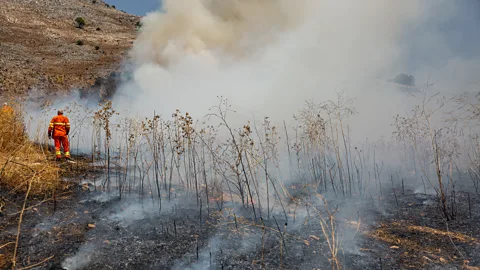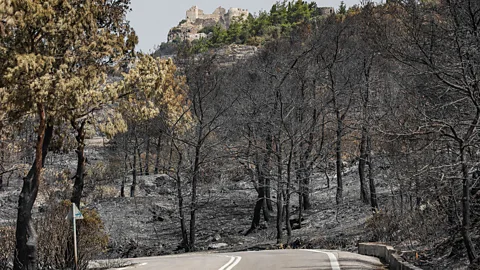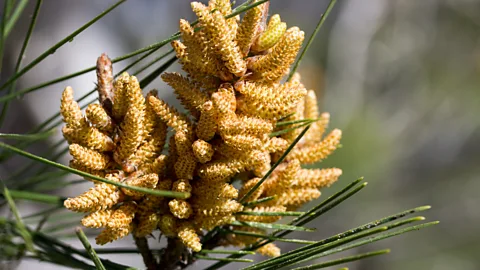How wildfires are changing face of the Mediterranean landscape
 Getty Images
Getty ImagesThe Mediterranean is a landscape that's always been shaped by fire. But now climate change is supercharging heatwaves and wildfires, the region is at risk of long-term change to its ecosystems.
Fires are raging once again in Greece, following the hottest June and July on record. By 12 August, the fire had affected 100,000 acres (405 sq km; 156 sq miles) of land. The extreme temperatures, which also affected Italy, Spain, Portugal, France and Morocco, would have been "virtually impossible" to reach without climate change, a preliminary analysis concluded.
It comes one year after another scorched summer fuelled by heat and strong winds. In 2023, 334,000 acres (1350 sq km; 521 sq miles) of land were left burnt in southern Europe in just 12 days, after fires broke out in mid-July. On the opposite side of the Mediterranean, huge wildfires in Algeria and Tunisia claimed dozens of lives and required widespread evacuations.
While the homes and lives devastated by the flames will take time to recover, there are also questions about how the habitats left scorched in their wake will be restored, especially with the growing threat of more wildfires each year due to climate change.
Wildfires have always been part of the life-cycle of Mediterranean ecosystems, but faced with ever-larger, more intense fires, can they keep rising from the ashes? Or are we witnessing a permanent change in the Mediterranean landscape?
"Mediterranean ecosystems are designed to burn," says Jenny Williams, a senior spatial analyst at the Royal Botanic Gardens in Kew, London, UK. Williams uses remote sensing – such drone or satellite imagery – to map changes in vegetation following forest fires. Wildfires, she says, are an important and natural occurrence. In fact, without fires, some species would cease to exist.
"[Many species have] hard casing on the seeds that don't release until fire ignites. Then, after a fire, you get this massive explosion of seedlings," she says.
 Getty Images
Getty ImagesThe Mediterranean, and other regions around the world with similar climates, are considered biodiversity hotspots. They account for 5% of the Earth's land surface, but contain 20% of its biodiversity. These regions, which can be found not only around the Mediterranean basin but also in Australia, California, South Africa and Chile, share the unusual climatic regime of mild, wet winters and warm, dry summers – and recurrent fire. Fires can even boost biodiversity. One recent study found higher biodiversity is linked to higher pyrodiversity.
"Pyrodiversity is the variability in the fire regime – its frequency, its intensity," says Adam Pellegrini, associate professor in plant sciences at the University of Cambridge. Pellegrini researches the traits that allow a plant to deal with fire and how changing fire regimes are impacting ecosystems and their ability to recover.
"Fire changes the conditions of the ecosystem," he says. "Right after a fire you can have more light, the soil can be hotter, ash can make the soil more alkaline… Different species are adapted to these different conditions. Look at a hillside in Greece, for example, and you might see a mosaic of areas at different stages of recovery. Different plant species specialise in those different stages. So, you start to see more biodiversity because variability in fire allows for more species to coexist."
Over millions of years, Mediterranean plants are thought to have evolved to survive fires by developing traits that help them to adapt to these conditions. Many trees have fire-resistant tissues in the form of thick bark and can even self-prune dead branches. Some plants store water in succulent tissues, while others' roots remain alive below-ground only to re-sprout post-fire. Heat-resistant seeds, too, lie stored in the soil awaiting their chance to grow. Forest fires can remove dead bark, wood and leaf litter from the soil so that new seedlings can establish and grow.
"Intact forests largely protect themselves," says Williams. "They restrict airflow, [reducing] the wind going through. If it's a closed canopy forest, you're looking at up to 10m [33ft] incursion for a fire. Then it peters out because it's not moving fast enough."
Problems come with human encroachment into nature – with pathways, roads, fences, lines cut into the wilderness.
"Once a fire has a little avenue in, it can burn in along those corridors," she says. "That becomes more and more, year on year. The gaps get bigger and the habitat doesn't have time to infill and protect itself."
And while many of the fire-resistant adaptations can help plant life survive lower intensity surface fires, they may struggle when faced with ferocious blazes fanned by drought and winds. Temperatures in the most intense wildfires can exceed 1,100C (2,000F). When ecosystems burn too fiercely or too frequently they can't regenerate effectively.
Now global warming is also reshaping Europe's pyroregions. For places where fire is a natural part of the ecosystem, climate-change-driven fires can be quite different from natural fire regimes. Extreme fire seasons are becoming longer, more common and increasingly unpredictable.
 Kew Gardens
Kew GardensA growing number of scientists believe that increases in fire frequency, intensity and scale are outstripping the capacity for ecosystems to recover. Depending on species and growth speed, vegetation needs between 25 to 250 years to reach maturity. Southern California's chaparral habitat, for example, can take 30-60 years to return to maturity after a wildfire. Canada's boreal and temperate forest ecosystems, on the other hand, appear to recover more rapidly – in around 10 years according to one study.
You might also like:
But as the interval between fires shortens, this recovery becomes harder to achieve.
Plus, when forests regrow after burning, they are smaller, younger and drier than before, so their carbon storage capacity is reduced. As fire severity increases, deeper layers of soil are damaged, releasing centuries-old "legacy carbon". High-intensity fires can also damage soil, cause erosion and prevent water absorption – all leading to biodiversity loss.
Some ecosystems never recover – studies in the Montane forests of the Rocky Mountains in the US, for example, suggest these will increasingly convert to grass and shrublands as forest fires rob them of their trees in a warming world.
Mediterranean ecosystems are particularly at risk. Many Mediterranean species depend solely on post-fire seed germination for recovery. According to one recent study, this is perhaps the most vulnerable fire-adaptation.
So, are we witnessing a changing Mediterranean landscape? Or do these ecosystems have the power to recover?
Perhaps both, says Williams.
"Mediterranean ecosystems are designed to burn. I think they can recover – but for the first two to three years it will look different. They've lost a lot of their soil and their natural protection. We're probably looking at about 15 years for a better kind of recovery. It's still probably going to be different though, a new normal."
In this changing climate, Williams says things will have to rebalance.
"Some species might not come back and that might be the new order of things. Change is always happening – and it isn't necessarily bad."
She hopes in the future we will see fully functioning ecosystems again – providing all the vital ecosystem services. And, she says, we can give natural regeneration a helping hand by starting small and working with local people. Rather than large-scale reforestation which has been seen to fail, Williams recommends "little in lots of places" to fast-track the recovery of these unique landscapes.
--
This story was originally published on 4 August 2023. It was updated on 13 August 2024 with details of Greece's latest summer wildfires.
--
